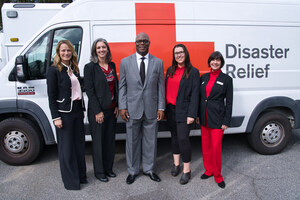WASHINGTON, July 7, 2017 /PRNewswire-USNewswire/ -- July has traditionally been the most popular month for Americans to travel the globe. If past years are any indication, millions of US citizens will set off on a global adventure this month. Whether travelers are driving across a border, sailing along a coastline, or flying halfway around the world, the American Red Cross recommends the following tips to stay safe before and during your travels:
- Know which natural disasters are possible. There's no reason to panic, but it's important to research whether your destination faces emergencies you've never experienced. While you'll need to gauge the local context, the Red Cross offers basic tips about what to do during natural disasters like tsunamis, volcanoes and hurricanes.
- Pack your International Certificate of Vaccination. Also referred to as the "yellow card," it lists your immunizations, allergies and blood type. The "yellow card" is available from your physician or local health department.
- Keep your destination country's emergency numbers handy. You know to use 9-1-1 in the United States, but how will you reach the fire department, police or an ambulance abroad? Find your destination country on this reference sheet from the US State Department—and write down the emergency numbers before you take off.
- Download the Red Cross First Aid App. This app puts expert advice for everyday emergencies in your hand. Be sure to download the app at redcross.org/apps while you're still in the U.S., so you can access the content even if you don't have phone service. If you have a firm handle on a foreign language, search for the local Red Cross or Red Crescent's mobile apps while abroad.
- Bring bug repellant. If you're traveling somewhere with mosquito-borne illnesses—such as malaria, dengue or Zika—be sure to spray insect repellent containing DEET (for children, use only products that contain less than 10 percent DEET). Wear long sleeves at critical times of the day.
- Check for evacuation routes and emergency exits. The Red Cross has helped communities around the world install signs that indicate evacuation routes in case a tsunami, flooding or another natural disaster occurs. Be sure to identify evacuation routes at your destination and always pay attention to the location of emergency exits.
- Register your trip with the US State Department. Enter your travel details with the free online Smart Traveler Enrollment Program, which allows the State Department to better assist you in case of an emergency while traveling internationally.
- Make a plan. Just like at home, it's important to establish a time and place to meet family members in case you get separated. Mobile service isn't always dependable, so plan accordingly.
Most importantly: have fun! The world is a beautiful place and adventure awaits. Once you've taken all these steps, you can cross "stress" off your list of things to pack. That leaves more room in your suitcase for souvenirs.
About the American Red Cross:
The American Red Cross shelters, feeds and provides emotional support to victims of disasters; supplies about 40 percent of the nation's blood; teaches skills that save lives; provides international humanitarian aid; and supports military members and their families. The Red Cross is a not-for-profit organization that depends on volunteers and the generosity of the American public to perform its mission. For more information, please visit redcross.org or cruzrojaamericana.org, or visit us on Twitter at @RedCross.
SOURCE American Red Cross
Related Links
WANT YOUR COMPANY'S NEWS FEATURED ON PRNEWSWIRE.COM?
Newsrooms &
Influencers
Digital Media
Outlets
Journalists
Opted In





Share this article